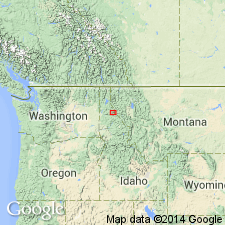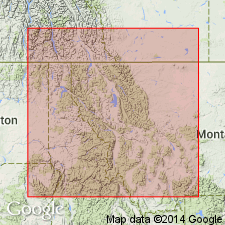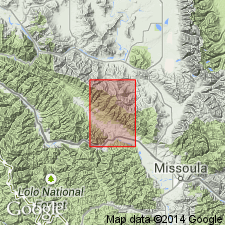
- Usage in publication:
-
- Revett quartzite*
- Modifications:
-
- First used
- Dominant lithology:
-
- Quartzite
- Sandstone
- AAPG geologic province:
-
- Northern Rocky Mountain region
Summary:
Intent to name not stated. Probably named for beds of Snowstorm mine, and those that surround Lake Revett and in the eastern part of the Coeur d'Alene district near the MT-ID border in Shoshone Co, ID in the Northern Rocky Mountain region. No type locality designated. Is homogeneous, consisting almost entirely of thick beds of white or gray quartzite interbedded with subordinate amount of micaceous sandstone. Has a greenish tint attributed to presence of sericite. About 1,000+ ft thick. Overlies Burke formation (first used) gradationally. Underlies St. Regis formation (first used). Of Algonkian age. No fossils have been found.
Source: GNU records (USGS DDS-6; Denver GNULEX).

- Usage in publication:
-
- Revett Formation*
- Modifications:
-
- Areal extent
- Overview
- AAPG geologic province:
-
- Northern Rocky Mountain region
Summary:
As the middle formation of the Ravalli Group of the Precambrian Belt Supergroup is limited to western part of Belt basin in the Northern Rocky Mountain region. See figures 4 and 5 for correlation with other formations in the Belt in the Northern Rocky Mountain region, and in the Purcell Supergroup of Alberta and British Columbia, Canada.
Source: GNU records (USGS DDS-6; Denver GNULEX).

- Usage in publication:
-
- Revett Formation*
- Modifications:
-
- Age modified
- AAPG geologic province:
-
- Northern Rocky Mountain region
Summary:
Is one of eleven formations of the Belt Supergroup mapped in the report area. Age changed from Precambrian to Precambrian Y, the age term used for rocks that range in age from 1,600 to 800 m.y. old. Is about 1,700 ft thick at Squaw Peak [now Ch-paa-qn Peak] in east-central part of quad. Thins to about 1,100 ft at north boundary of quad. Lower contact with Burke Formation of Belt placed at base of lowermost vitreous white quartzite of Revett. Underlies St. Regis Formation of Belt. Mapped in northwest part of quad in Sanders and Missoula Cos, MT in the Northern Rocky Mountain region.
[NOTE: Geographic feature Squaw Peak renamed Ch-paa-qn Peak (U.S. Board on Geographic Names, March 2004, USGS GNIS FeatureID 791393).]
Source: GNU records (USGS DDS-6; Denver GNULEX).
For more information, please contact Nancy Stamm, Geologic Names Committee Secretary.
Asterisk (*) indicates published by U.S. Geological Survey authors.
"No current usage" (†) implies that a name has been abandoned or has fallen into disuse. Former usage and, if known, replacement name given in parentheses ( ).
Slash (/) indicates name conflicts with nomenclatural guidelines (CSN, 1933; ACSN, 1961, 1970; NACSN, 1983, 2005, 2021). May be explained within brackets ([ ]).

